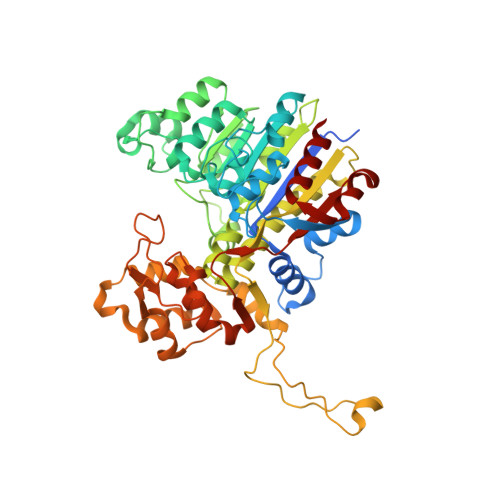Structural characteristics of alkaline phosphatase from the moderately halophilic bacterium Halomonas sp. 593.
Arai, S., Yonezawa, Y., Ishibashi, M., Matsumoto, F., Adachi, M., Tamada, T., Tokunaga, H., Blaber, M., Tokunaga, M., Kuroki, R.(2014) Acta Crystallogr D Biol Crystallogr 70: 811-820
- PubMed: 24598750
- DOI: https://doi.org/10.1107/S1399004713033609
- Primary Citation of Related Structures:
3WBH - PubMed Abstract:
Alkaline phosphatase (AP) from the moderate halophilic bacterium Halomonas sp. 593 (HaAP) catalyzes the hydrolysis of phosphomonoesters over a wide salt-concentration range (1-4 M NaCl). In order to clarify the structural basis of its halophilic characteristics and its wide-range adaptation to salt concentration, the tertiary structure of HaAP was determined by X-ray crystallography to 2.1 Å resolution. The unit cell of HaAP contained one dimer unit corresponding to the biological unit. The monomer structure of HaAP contains a domain comprised of an 11-stranded β-sheet core with 19 surrounding α-helices similar to those of APs from other species, and a unique `crown' domain containing an extended `arm' structure that participates in formation of a hydrophobic cluster at the entrance to the substrate-binding site. The HaAP structure also displays a unique distribution of negatively charged residues and hydrophobic residues in comparison to other known AP structures. AP from Vibrio sp. G15-21 (VAP; a slight halophile) has the highest similarity in sequence (70.0% identity) and structure (C(α) r.m.s.d. of 0.82 Å for the monomer) to HaAP. The surface of the HaAP dimer is substantially more acidic than that of the VAP dimer (144 exposed Asp/Glu residues versus 114, respectively), and thus may enable the solubility of HaAP under high-salt conditions. Conversely, the monomer unit of HaAP formed a substantially larger hydrophobic interior comprising 329 C atoms from completely buried residues, whereas that of VAP comprised 264 C atoms, which may maintain the stability of HaAP under low-salt conditions. These characteristics of HaAP may be responsible for its unique functional adaptation permitting activity over a wide range of salt concentrations.
Organizational Affiliation:
Quantum Beam Science Directorate, Japan Atomic Energy Agency, 2-4 Shirakata-shirane, Tokai, Ibaraki 319-1195, Japan.

















